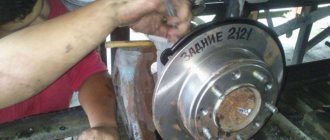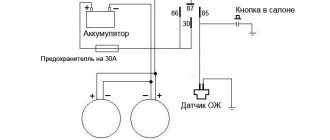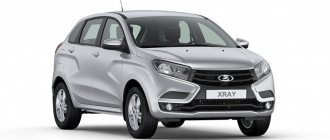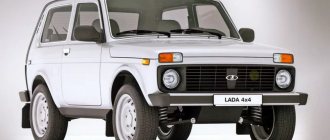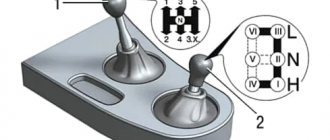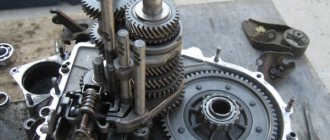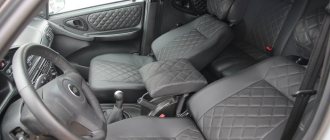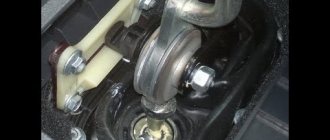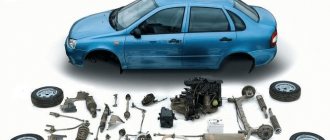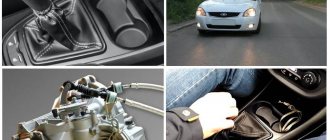The transmission design of all Niva models, starting with the VAZ 2121 and up to the VAZ 2131, has permanent all-wheel drive on all four wheels with a locking center differential. The design consists of a gearbox, transfer case, front and rear driveshafts, front and rear axles.
Torque from the engine is transmitted through the gearbox to the transfer case, which redistributes it in two directions, to the front and rear axles. Next, the torque from the transfer case, through the front and rear cardans, is transmitted to the front and rear gearboxes. The torque from the front gearbox, through the front gearbox differential and the left and right constant velocity joint (CV joint) is redistributed to the left and right front wheels of the car. The torque from the rear gearbox through the rear gearbox differential and the left and right axle shafts is redistributed to the left and right rear wheels of the car. Since the torque is driven to all four wheels, it is called full-wheel drive. And since the design constantly transmits torque to all four wheels, it is called permanent all-wheel drive or in the international designation 4WD.
What differentials are locked on the Niva?
On the way, when transmitting torque from the engine to the wheels of the car, the Niva design provides three differentials. The first, the center differential, redistributes torque to the front and rear axles of the car. Niva has it blockable. The center differential is locked using a small transfer case control handle. When the center differential is locked, the warning light on the instrument panel lights up.
The other two differentials are cross-axle and are located in the front and rear gearboxes. They redistribute torque to the left and right wheels. These Niva differentials are free (that is, they do not lock).
When and why do you need to block the center differential?
The center differential must be blocked when overcoming difficult sections of roads. Such areas include: off-road, sand, steep ascents and descents. When the center differential is locked, the same torque begins to be transmitted to both axles of the car (ALER: Error! See article Niva Drive)
. In this regard, situations of slipping of the front axle of the car in relation to the rear axle are eliminated, which increases its maneuverability.
It is advisable to lock the differential before overcoming an obstacle, and not after the car is stuck. This allows you to avoid many unpleasant situations.
I locked the center differential, but was still stuck. At the same time, I noticed that only two wheels were spinning, one in the front and one in the back. How can it be?
When the center differential is locked, the same torque is transmitted to the front and rear axles of the car (ALER: Error: the angular velocity is the same, not the torque. See the article Niva drive)
. Therefore, at least one wheel will rotate on the front and rear axles. If the center differential were not locked, then only one wheel on one axle of the car would rotate.
Nivov transmission units
The developed Niva transmission turned out to be so successful and efficient that it later became a prototype for the Vitara. This made the new model more adaptable to difficult roads. Niva transmission units can easily meet the requirements of any engine up to 2 liters, so if you want to upgrade, think about the fact that each car has its own capabilities. Many advantages are due precisely to the circuit and design of the transmission.
Niva transmission and its components:
- front-wheel drive;
- front axle;
- wheel grip;
- manual transmission;
- driveshaft (front);
- shaft (intermediate);
- transfer case;
- shift lever;
- center differential and locking lever;
- wheel differentials;
- driveshaft (rear);
- rear axle;
- rear drive.
The design implies the following states:
- unlocked differential;
- locked differential;
- low gear when engaged;
- neutral position;
- top gear engaged.
Diagnostics and repair of the speed box
To carry out a full diagnosis, the speed box must be removed. As a rule, there is a need for this if vibrations, extraneous noise, or oil leakage increase during movement.
How to remove the box? Before you begin removing the gearbox, you must remove the transfer case. Without an inspection hole, it will be difficult to carry out repair work, for example, unscrewing the cardan shafts from the transfer case. The stabilizer can also be removed. The housing of the air filter element must be removed.
In order to remove the gearbox, you should disconnect the lever rod, the clutch housing cover fastenings, the driveshaft, bolts, nuts, and remove the bracket. The suspension of the power unit is adjacent to the body. To remove it you need to unscrew the fastening nuts.
To extend the service life of the VAZ 21213 gearbox, it is advisable to periodically check the level of transmission fluid and change it in a timely manner.
It should be noted that often the appearance of extraneous noise from the gearbox is a consequence of the fact that there is a low level of transmission oil in the system.
Mineral oil can be added to the machine. However, semi-synthetic and synthetic options have better performance. The advantage of the latest types of oils is that even in winter the gears will be easily engaged.
Timely maintenance of the Niva gearbox allows you to avoid a complete overhaul of the gearbox. Assembling all the dismantled parts is a painstaking task, so it should be trusted to professionals. Replacing the gearbox input shaft bearing is a common procedure that is ordered at a service center.
Didn't find the information you are looking for? on our forum.
Features of the Nivov design
The features of the Nivov transmission include the presence of a center differential that connects the rear and front axles. As a result, the wheels can rotate not only at different angles, but also at different angular speeds, which significantly affects controllability in impassable roads.
The center differential is located in the transfer case and is similar in design to the cross-axle differential.
The key difference between the Niva’s center differential is the ability to lock when driveshafts rotate with the same characteristics. The center differential is manually locked only in difficult terrain conditions, when you need to overcome a large hole, rut or snow drift without slipping.
In practice, mechanical locking, although somewhat inconvenient, turns out to be better than the modern electromagnetic clutch used for these purposes. For example, the Renault Duster is not so easy to cope with the task in harsh off-road conditions, since the digital control unit can provide limited torque transmission. However, this effect will not be observed in a Niva with a mechanical lock.
Tips for owners
To make driving your car comfortable, read some important points:
- The usual, standard arrangement of the front and rear handles is forward and backward, respectively. Movement in this mode can and should be carried out in areas characterized by even and smooth surfaces.
- Locking the differential by switching the front handle to the rear position is best on roads characterized by increased slipperiness. This measure will give Niva stability. It is worth understanding that after overcoming the problem area, the handle will need to be returned to its original position.
- As noted earlier, downshift should be activated before a potential obstacle, but not while the car is already stuck.
- It is worth understanding that activating the lock when the vehicle is stationary is sometimes impossible, even if the clutch is depressed. This may be caused by the clutch teeth hitting the gear teeth. In this case, you can try to activate the lock by starting to drive slowly and make a slight turn. If problems arise with disabling the lock, it is recommended to perform the same procedure with the clutch depressed and the steering wheel slightly rocked.
Modified versions
The Niva's standard transmission, for all its advantages, often causes uncomfortable noise in the cabin. This is generally related to the design, but using engineering developments, you can modernize it and make the car much quieter.
This approach has already been applied in VAZ-21213 cars; as a result, even at a speed of 100 km/h you don’t feel any unpleasant noise, you can talk calmly and hear your interlocutor without effort. For these purposes, a number of modernization methods have been used: from unloading the floor near the transfer case and manual transmission mounts, reducing the load on shaft bearings to smoothing out peak torques under conditions of increasing loads on the transmission. The effect is achieved by changing the mounting location of the front axle gearbox, which in the modernized version is suspended at a distance from the engine on rubber supports. This approach makes it possible to reduce to a minimum the reactive torque in the longitudinal-vertical direction and the noise level at speed.
The noise in the modernized Niva transmission is comparable to that of a Zhiguli. It becomes more comfortable to be in the car when driving off-road. Upgrade costs are negligible; modification requires only the master's understanding of the design itself and a little time.
Recently, SUVs and crossovers with all-wheel drive have become very popular. If previously preference was given only to cars with high ground clearance, now the presence of a 4x4 transmission is a priority.
But such technology can be implemented in completely different ways; let’s look at the structural features of the center lock and clutch on a Chevrolet Niva car.
INTRODUCTION
The purpose of the educational practice: To study the general devices of the VAZ-2131 car, the basics of the production process of the enterprise JSC SPK; car service stations, the basics of the production process of car operation and repair.
Objectives of industrial practice:
- — study the general devices of VAZ-2131 cars;
- — study the purpose and principle of operation of components, systems, mechanisms and assemblies of automobiles;
- — study the organizational structure and tasks of the functioning of a road transport enterprise, its individual services and divisions;
- — study the technologies and rules of maintenance and repair of parts, assemblies and systems of automobile transport.
Drive device.
The classic Niva 2121 became the first Russian SUV to be equipped with an all-wheel drive transmission. Among the main features of this transmission was the ability to lock the center differential. Many people mistakenly believe that this unit is necessary to connect the front axle. But in reality, the front axle is always in the connected position. Let's try to understand the design of the car in more detail.
The chassis of the car is designed in such a way that torque from the engine is transmitted through the gearbox to all 4 wheels at once. This operating scheme allows you to show the best performance when moving off-road, while at the same time significantly reducing the cost of the main parts.
Main transmission components:
- Gear box,
- Razdatka,
- Drives and cardan shafts,
- Front and rear gearboxes.
It is the transfer case in the car that is responsible for distributing torque between the axles. On the Chevrolet Niva it is two-speed and its presence provides the following advantages:
- Smooth vehicle movement at low speeds at high engine speeds.
- Distribution of forces between the axles of the car depending on specific road conditions.
The differential is necessary to distribute traction forces. In practice, this allows two wheels to rotate on the same axis at different speeds. The Chevrolet Niva has 3 differentials, which allows each wheel to have its own angular velocity.
Cardan shafts are necessary to connect transfer cases and axle gearboxes. Chevrolet Niva shafts have one interesting feature: they have exactly the same design, as a result of which they are interchangeable and if one of them fails, if necessary, you can sacrifice all-wheel drive, but get to the nearest service station yourself.
The axles are equipped with internal hinges that transmit force from the transfer case to the drive wheels.
Differential
This mechanism is a kind of distributor of traction forces coming from the motor to the wheels. An important feature is that the latter have the ability to rotate at different speeds. The importance of having a differential mechanism is due to the fact that during turning maneuvers, the wheel located inside makes fewer revolutions when compared with the number of turns of the outer wheel.
Operating principle of the drive.
By default, the SUV uses high gear with the center differential disabled. The engine transmits force to the gearbox, which is fed through the shaft to the transfer case gearbox. The transfer case contains a center differential, which connects the front and rear axles.
How does all-wheel drive work on a Chevrolet Niva if the differential is locked.
If you turn on all-wheel drive on the Niva, the cardan shafts will be blocked using a special clutch. In this case, there will be an even distribution of torque between the axles. The vehicle's cross-country ability will increase significantly, but at the same time, handling will become slightly worse.
A series of downshifts
You can often encounter the following type of misconception: switching the rear handle can increase the power characteristics of the motor. But this is not true. It serves to change the gear ratio between the engine and the wheels. By increasing it, the traction forces on the wheels will increase. There is also a reduction gear in the dispensing mechanism.
DON'T WASTE MONEY ON REPAINTING! Now you can remove any scratch from the body of your car in just 5 seconds.
Its operation can be controlled using the rear handle. When we shift the lever back, we will have a gear ratio of 2.135 - this is a low gear. It is recommended to downshift such a gear only when the car is stationary and the clutch is depressed. Despite the fact that the manual does not contain such a restriction, novice and inexperienced Niva drivers are not recommended to switch while driving, since the Niva transfer mechanism is not equipped with a synchronizer.
Turning on all-wheel drive.
The use of blocking will be justified in the following cases:
- If there is a possibility of wheel slipping, in areas with poor surface conditions,
- If there is a lack of engine thrust at high speeds,
- When driving on roads with loose surfaces, snow, ice.
You should also take into account some features of the Chevrolet Niva, namely, the helplessness of the transmission when hanging diagonally. In this mode, the wheels begin to spin, so if necessary, you need to dig under the wheel or make an embankment under the raised axle.
